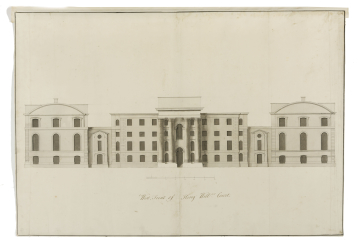Scale
10 feet to 17/20 inch
Inscribed
In pen and brown ink in unidentified hand from office of Thomas Ripley, West Front of King Willms: Court.; and in grey ink with numbered scale bar; and by C19 hand at both right-hand corners, 31.
Signed and dated
- Unfdated but datable c.1735
Medium and dimensions
Pen and grey ink over graphite under-drawing, with grey washes; black ink ruled border; on laid paper, laid down; 496 x 732
Hand
Unidentified hand in the office Thomas Ripley
Watermark
Strasbourg Lily / 4 / LVG; IHS / IVILLEDARY
Notes
This drawing was probably prepared for engraving at the time that Ripley finalised the overall plan of the Hospital and the design of Queen Mary's Court. It incorporates revisions to the several features of the elevation. The outer square columns of the portico have been changed to round columns and made narrower, to equal the diameters of the middle columns, and all the columns are unfluted. At the top of the central block Ripley has removed the blocking course that runs into the cornice of the central pavilion at an arbitrary point, just above the bottom of the corona moulding. The cornice is now the crowning element of the wall (although roofs and chimney stacks would still have been in view). The outer pavilions have lost their low, elliptical-headed recesses. The tympanums of these curved pediments are plain, and the blocking courses either side have been raised to provide a backing for the squat elliptical pediments. The blocking courses are positioned to produce a perfect square proportion for the elevation as a whole (65 x 65 feet). Ripley has also raised the central blocking course above the portico. The effect of this change is to make the central portico (now more regular in its proportions) a more dominant feature of the composition, and one that more closely resembles the design of the classical temple portico. The draughtsman responsible for this drawing is not the same as for [12/25]. The numbering and convention of the scale bar are different and the wash technique is less even.
Literature
Wren Society, VI, pl. 33, right.
Level
Drawing
Digitisation of the Drawings Collection has been made possible through the generosity of the Leon Levy Foundation
Sir John Soane's collection includes some 30,000 architectural,
design and topographical drawings which is a very important resource for
scholars worldwide. His was the first architect’s collection to attempt to
preserve the best in design for the architectural profession in the future, and
it did so by assembling as exemplars surviving drawings by great Renaissance
masters and by the leading architects in Britain in the 17th and 18th centuries
and his near contemporaries such as Sir William Chambers, Robert Adam and
George Dance the Younger. These drawings sit side by side with 9,000 drawings
in Soane’s own hand or those of the pupils in his office, covering his early
work as a student, his time in Italy and the drawings produced in the course of
his architectural practice from 1780 until the 1830s.
Browse (via the vertical menu to the left) and search results for Drawings include a mixture of
Concise catalogue records – drawn from an outline list of the collection – and
fuller records where drawings have been catalogued in more detail (an ongoing
process).


